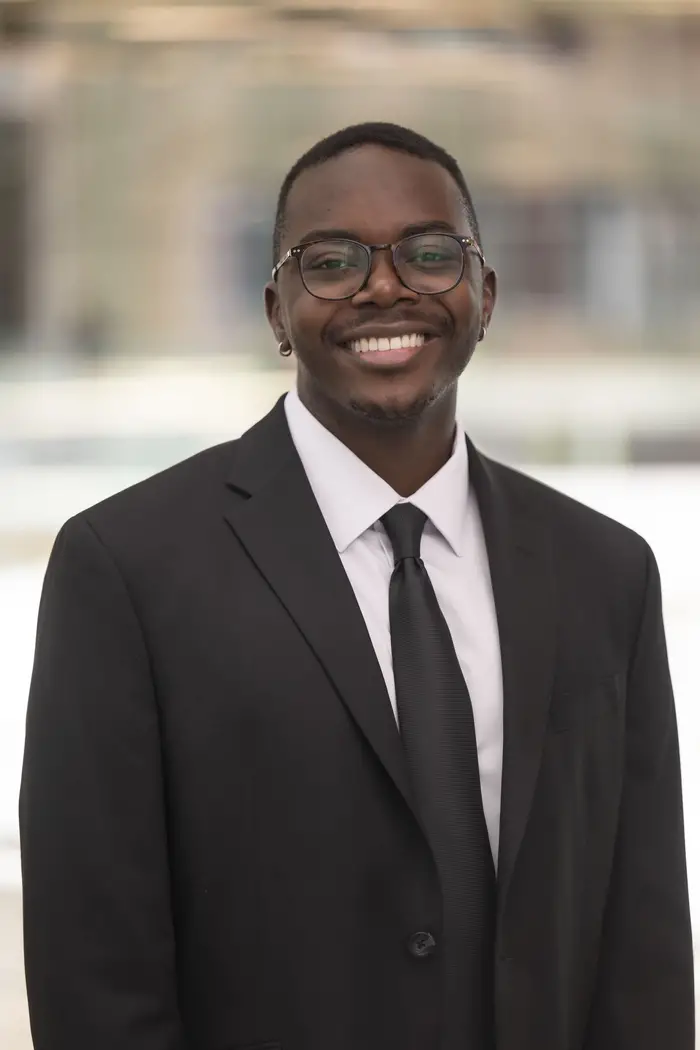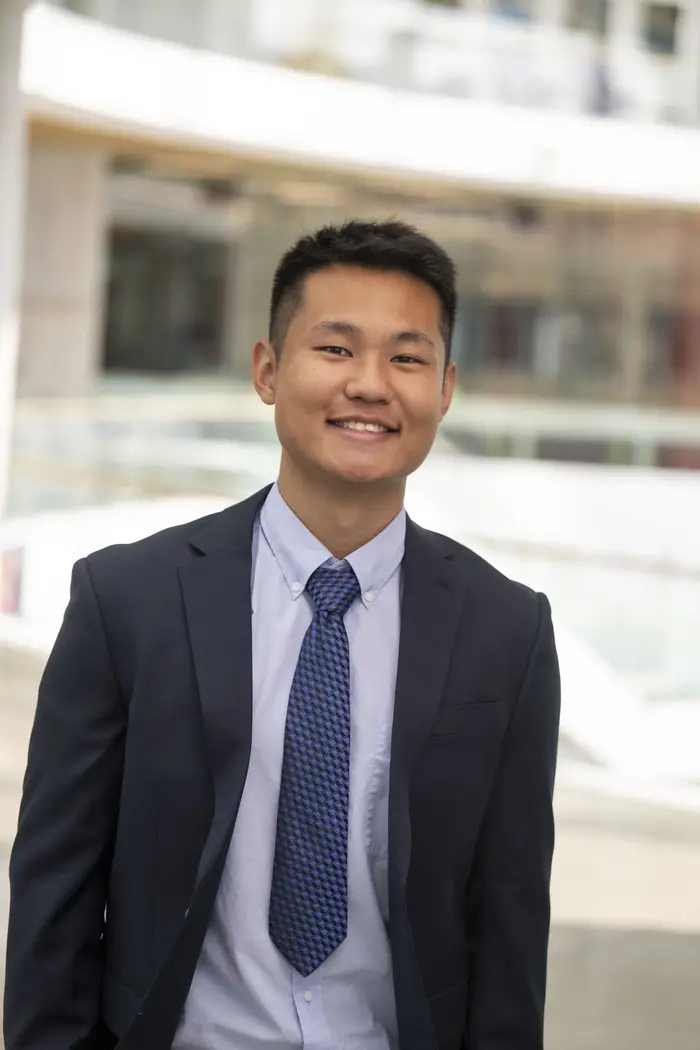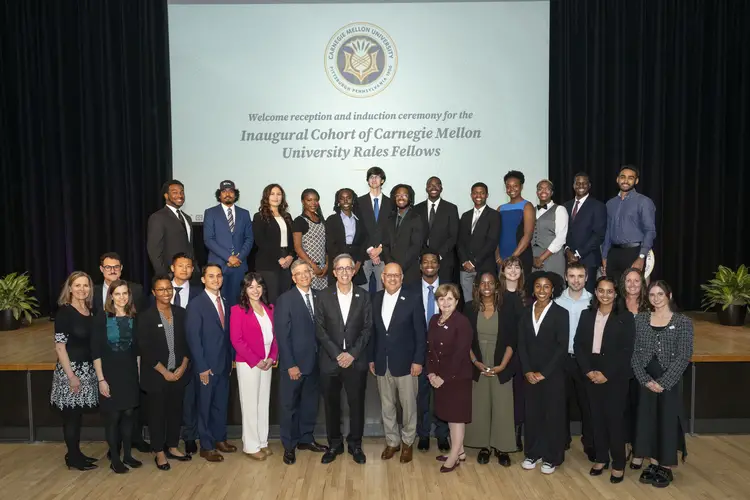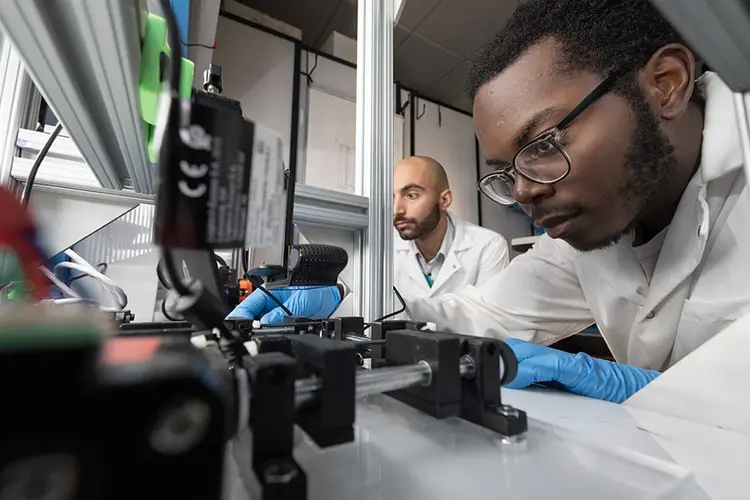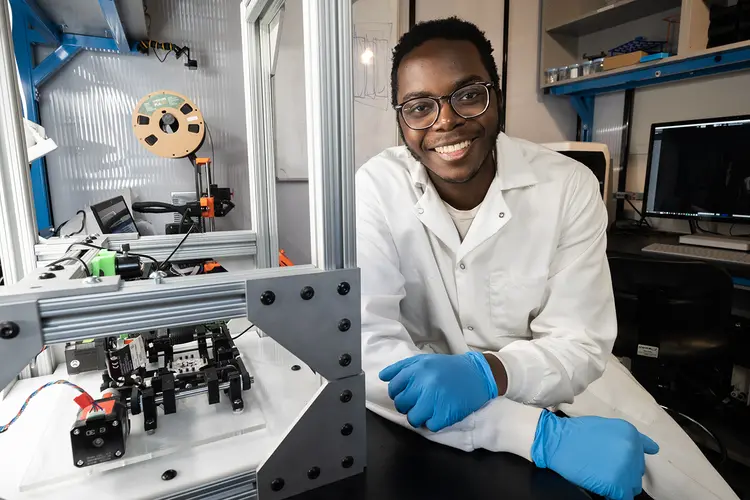Rales Fellowship Paves Way for Mechanical Engineers To Pioneer Health Solutions
Media Inquiries
Lameck Beni is a curious problem solver who discovered his passion for engineering at a science fair in elementary school.
“It was a bridge-building competition. The directions were pretty straightforward: Build a bridge using only balsa wood and glue that is as light as possible while still being able to support the heaviest weight it can,” he said.
Beni arrived with the tiny bridge he created only to find himself competing with bridges many times larger and more elaborate than his. He was sure his bridge was going to crumble under just a pound of force. Not only did Beni’s bridge win third place, it proved one of the strongest in the competition.
“That bridge competition taught me it’s less about aesthetics and more about the engineering or the science behind what you're creating that’s important, and that sparked an interest in me to become an engineer,” he said.
Beni graduated with a bachelor’s degree in mechanical engineering(opens in new window) from Carnegie Mellon University with an additional major in biomedical engineering(opens in new window). He is now pursuing graduate studies as a CMU Rales Fellow(opens in new window) with a focus on medical devices designed specifically for cancer research, therapy and diagnosis.
“Cancer can happen to anyone, and I think the therapy, treatment and diagnosis for it could be better,” he said. “I hope to leverage my skills, my time in the classroom and my research to make cancer more easily treated or detected.”
Eric Zhao was introduced to Carnegie Mellon through its Pre-College Programs(opens in new window) in 2019, and went on to earn a bachelor’s degree in mechanical engineering from the university with an additional major in Chinese studies(opens in new window). Now through the CMU Rales Fellows Program, he is developing custom prosthetic liners for individuals who have experienced an above-the-knee amputation.
“It’s very fulfilling to work on products that address a real need and can significantly improve people’s lives,” Zhao shared.
Exploring custom prosthetic solutions aimed at greater comfort and mobility
Central to Zhao’s research are lattices — honeycomb-like structures that mimic the arrangement of atoms in materials such as diamonds. In CMU’s Computational Engineering and Robotics Laboratory (CERLAB) led by Kenji Shimada(opens in new window), Zhao uses a proprietary lattice generation program to create complex and unique structures tailored for various applications, from redesigning aerospace components to developing custom shoe insoles for diabetic patients aimed at alleviating discomfort from foot ulcers.
“Lattices are particularly advantageous because, when designed effectively, they can deliver equal or superior mechanical properties while minimizing weight and volume,” he said.
“For instance, replacing solid support columns with a honeycomb structure can achieve the same strength with less material, resulting in cost savings.”
The flexibility of the lattice generation program allows for a high degree of design freedom. By collecting stress and pressure data from simulations or actual patient experiences, Zhao can input information into the program to generate a lattice specifically tailored to an individual's needs.
“This innovative approach enables the creation of prosthetic liners that are denser in certain areas for enhanced support and comfort, while also reducing overall weight and improving airflow to the residual limb,” he said. “I really hope that we can make this into an accessible solution because of the inequalities and lack of development in current commercial prosthetics.”
Advancing precision medicine through small-scale technologies
Beni recently began working in Siyang Zheng(opens in new window)'s lab, where he is researching the creation of small-scale technology for precision medicine. One focus area is developing technology for cancer detection through liquid biopsy, which is essentially detecting cancer cells or cancer-related markers through analyzing a sample of a patient's blood.
“This process is more straightforward and noninvasive, and it can help catch cancer early, which improves cancer recovery rates,” Beni said.
Another focus area of his is "lab-on-a-chip" technology, which involves creating models of parts of the human body at a small scale.
“It’s kind of like shrinking an organ and putting it on a small glass plate,” he said. “These models would allow researchers to quickly test treatments on specific parts of the human body, which would enable them to more efficiently find the best treatments for patients.”
His current project involves designing and creating a device that guides how heart valves grow in a heart-on-a-chip model.
“This project isn't specifically cancer focused, but still advances technology and understanding of on-a-chip technology,” he said.
The impact of having a supportive community
Zhao reflects on his time at CMU with gratitude, appreciative of the supportive community he found at the university, which he said has enriched his experience.
“Being a Tartan Scholar(opens in new window) was particularly impactful, connecting me with peers from similar backgrounds. Exceptional resources like the summer research programs (SURA and SURF)(opens in new window) enabled me to explore my academic interests in research and computer science without incurring extra costs,” he said.
Beni said he has enjoyed the variety of opportunities available to him at CMU.
“There's always something going on. Last year, someone talked me into helping them build a booth for Spring Carnival, and we ended up winning first place in our division,” he said.
“I’ve been able to participate in a lot of different kinds of activities,” he added, “just through meeting people and being open to new things.”
Benefits of being a Rales Fellow
The CMU Rales Fellows Program is dedicated to cultivating the next generation of science, technology, engineering and math (STEM) leaders and driving innovation by increasing access to graduate education. The program offers a holistic, cohort-based experience that emphasizes mentorship from faculty, advisors and peers. Fellows benefit from exclusive professional development and networking events featuring academic and industry leaders, alongside personalized career coaching to help guide their professional journeys.
Beyond reducing the cost barrier to graduate studies, Beni said the Rales Fellows Program appealed to him largely because of its personalized career coaching and cohort-based experience.
“I never thought of myself as a leader, but now I'm starting to see how I fit into that role. The Rales Fellowship has given me a boost in confidence,” he said. “I hope to have a role in research and development, and often those positions require a higher degree level. At the end of the day, I want to be someone who is helping people in a way that has the broadest impact possible.”
Zhao also thinks the cohort experience is one of the best aspects of the Rales Fellow Program.
“I’ve really enjoyed getting to know such an amazing group of people who are driven and focused on working with their communities to have a positive impact. It’s my favorite part about the program,” Zhao said.
“We are all in different majors, but we all share similar values. I already feel close to many of the people in the program, and that’s something that has always been important to me, building a strong, supportive community.”
